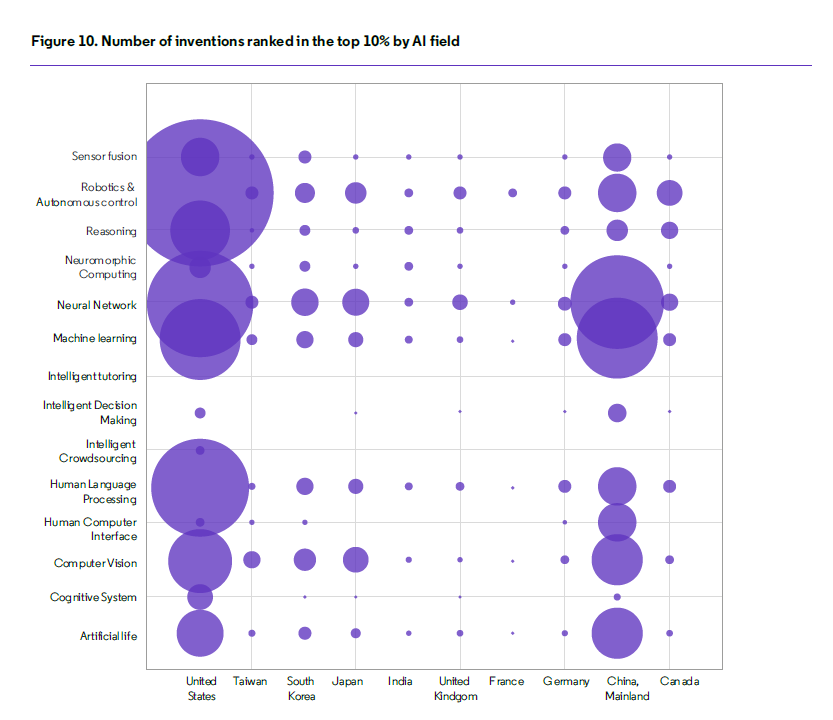
Part #2 of 2 Parts
Korea’s Plan for AI/ML Dominance...Brilliant!
Korea looks to ramp up artificial intelligence and converge with recent successes in robotics (6x growth from 2009 to 2016). Can Korea pull it off?
Korea, population 51 million, is positioning itself to become the AI powerhouse of East Asia, and a major contender for world leadership as well.
Korea looks for advantage
If you were a member of Korea’s Artificial Intelligence (AI) strategy team, sitting around a table and looking down on these two pie charts, you’d be more than a bit bemused searching between the pie charts for any mention of Korea.
One pie chart asks the question: “Where do top-tier AI researchers work today?”
The other pie chart asks: “Where do top-tier AI researchers come from?”
On both of the pie charts, Korea is conspicuously absent.

The third largest economy in Asia, number 10 worldwide, and the world leader with 1,000 industrial robots deployed per 10,000 workers (2021), Korea could distinguish itself all the more by creating a hefty piece of pie for itself in each of the top-tier charts.
Korea’s quest for artificial intelligence (AI/ML)
Korea, to its credit, didn’t panic over the worldwide quest to integrate AI excellence into its technology. Rather, it looked long and hard—but as briefly as possible—before taking quick action.
KAIST or the Korea Advanced Institute of Science and Technology, a national research university, and KAIST’s Innovation Strategy and Policy Institute (ISPI), hired UK-based innovation think tank, Clarivate; and rapidly (2021) the two put out a report of observations, insights, conclusions, and next steps for Korea to build out an AI-acquisition blueprint: The innovation landscape of artificial intelligence [Report].
Korea and the great mating game: AI & robotics
Artificial intelligence is beginning to converge with both industrial and service robotics in remarkably mind-bending ways. Almost daily, headlines announce one or another astonishing, heretofore never realized achievement, for this pair of converged technologies.
The body and the mind of technology are no longer separated. Like long-lost family members finally finding each other, the pair together is changing our world! From science to medicine to manufacturing, from bio laboratories to warehouses, from ordinary household chores to brain surgery to making computer chips, humans are training the pair to work as one. The results are nothing short of astounding.
Now, every robot vendor and developer worldwide has a 600-lb AI gorilla in its conference room that must be integrated into its robotics business. To fail that integration could be calamitous, so say the forecasters and analysts. Not only businesses but every nation is faced with the very same technology challenge and consequences.
As such, a race is now afoot seemingly everywhere at once, with the objective to gain some sort of edge, whatever that edge might be, that creates an advantage for the racer’s country, company, or clan.
To date, the top 10 countries produce 92% of the world’s total AI inventions, and their total gross domestic product (GDP) represents 41% of the world’s total GDP.

“The innovation landscape of artificial intelligence”: Key findings
The Clarivate/KAIST report conveniently pointed out what global leaders in the AI space were doing, and how they were getting it done. As shown in these tidbits:
“Neural networks and machine learning have been unrivaled in terms of scale and growth (more than 46%), and most other AI technologies show a growth rate of more than 20% since 2010.
“Although Mainland China has shown the highest growth rate in terms of AI inventions, the influence of Chinese AI is relatively low. In contrast, the United States holds a leading position in AI-related inventions in terms of both quantity and influence.
“The U.S. and Canada have built an industry-oriented AI technology development ecosystem through organic cooperation with both academia and the government. Mainland China and South Korea, by contrast, have a government-driven AI technology development.
“The U.S., the U.K., and Canada have a relatively high proportion of inventions in robotics and autonomous control, whereas in Mainland China and Korea, machine learning and neural networks are making progress. Each country/region produces high-quality inventions in their predominant AI fields, while the U.S. has produced high-impact inventions in almost all AI fields.”
Korea’s Yellow Brick Road
The obvious Yellow Brick Road to success in AI is to follow those who are convincingly succeeding at it on a very high level. Since the union of academia and the government worked well for the U.S., the U.K., and Canada. And since “The U.S., the U.K., and Canada have a relatively high proportion of inventions in robotics and autonomous control,” then the obvious road to travel for Korea is that of the U.S., the U.K., and Canada.
And that’s exactly Korea’s roadmap. Follow along, join up, and do whatever needs to be done to dominate.
So, who’s doing what?
Government:
Part 1 of this report sets out the $177 billion that Korea has anted up for its New Deal, officially titled Korean New Deal: National Strategy for a Great Transformation.
According to the Minister of Trade, Industry and Energy, from an interview with the Korea Herald, major investment amounts will be made in service robots, funds to foster robots to cater to growing needs in areas of caring, clothing, and logistics, to create a healthy ecosystem for robot businesses, and new technologies like artificial intelligence and the fifth-generation network (5G).
Academia:
The guiding academic force will fall to KAIST and to KAIST’s Innovation Strategy and Policy Institute (ISPI) that aims to broaden the dynamic landscapes of innovation and entrepreneurship. The Institute focuses on how the new innovation paradigm of digitization and the new industrial revolution affect our society.
Industry:
With Korean industry, investment and general involvement with AI starts to really get interesting. For example:
LG: LG Corp. and its artificial intelligence research institute set up its first overseas base in Michigan to expand its global AI research ecosystem to North America. The institute said on Wednesday it has opened LG AI Research Center, in Ann Arbor.
HYUNDAI: Hyundai Motor Group invested $424 million to establish an AI research center in Cambridge, Massachusetts to be headed up by Mark Raibert, the founder and chairman of US robotics company Boston Dynamics Inc. Boston Dynamics was acquired by Hyundai in 2020.
SAMSUNG: Samsung Group operates six AI R&D centers worldwide, in Silicon Valley, New York, Cambridge (UK), Toronto, Montréal and Moscow. In June, Samsung AI Center Montréal moved to another location downtown, doubling the size of the original lab with 15 new research scientists to apply advanced AI to telecommunications, machine learning, robotics, and other multi-modal interactions. Samsung also runs (since 1997) the Samsung Israel R&D Center (Herzlyia, Israel)
SK GROUP: SK Group second largest conglomerate behind Samsung) operates Gauss Labs Inc., a Silicon Valley-based AI R&D established in 2020. The center is focused on industrial AI solutions, aiming to solve the challenges of the semiconductor manufacturing process.
NAVER CORP: Naver Labs Corp Korea’s own online giant Naver Corp. is set to enter the local smart building market with its cloud-based 5G networks and artificial intelligence robots.
KOREA-ISRAEL: as the Korea-Israel Industrial R&D Foundation will offer funding of up to $5.3 million per joint robotics project, with special emphasis on four sub-sectors: health, logistics, agriculture and livestock, and domestic services (such as assistance for people with disabilities).
Pie charts say a lot
In passing, it’s good to note that for the all-important pie charts above “Where top-tier researchers work and come from,” that about 600 new AI doctoral researchers come from Toronto, let alone more per year from Canada’s University of Waterloo and Université de Montréal. Korea graduates barely 100 from eight graduate schools for AI studies.

